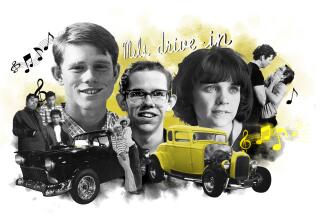‘Two-Lane Blacktop’ took detour into cult-fave land
Released in 1971 by the newly created youth division of Universal Studios, Monte Hellman’s “Two-Lane Blacktop” is both a generational artifact and a movie that seems to exist out of time. Richard Linklater has called it the last film of the ‘60s and the first film of the ‘70s. Indeed, Hellman’s cross-country road movie is a quintessential product of post-”Easy Rider” Hollywood, a film that got made only because the studios had identified the counterculture as a demographic.
Despite its period specificity, “Two-Lane Blacktop,” out this week in a director-approved edition from the Criterion Collection, is a strange, even abstract film. To match the nameless characters, it’s a movie of obscure motivations and open-ended implications. The two lank-haired hot-rodders, who go from town to town in their souped-up 1955 Chevy and get into drag races for money, are simply identified as the Driver (singer-songwriter James Taylor) and the Mechanic (Beach Boys drummer Dennis Wilson).
Joining these decidedly inexpressive rock stars (and first-time actors) is the Girl (Laurie Bird, also a nonprofessional and an even drowsier presence), a hitchhiker who simply shows up in their back seat one day. As with the two male characters, her name sums up her function, though it could be argued that the guys’ beloved car has the real girl role (and the point at which the Girl usurps that role is when things start to fall apart).
The plot is so thin it barely exists, but “Two-Lane Blacktop” exerts a hypnotic power all the same. Somewhere in the arid Southwest, our heroes cross paths with a middle-aged huckster (Warren Oates) who’s driving a brand-new, bright-yellow Pontiac GTO (the character is known only as GTO). A challenge is issued: They will race all the way east to Washington, D.C. -- the winner gets the loser’s car.
This would appear to set the stage for a tense showdown, but the contest, far from streamlining or galvanizing the plot, unravels it. A significant chunk of the movie takes place in cars and to the sound of roaring engines -- Hellman said he had to convince the money men that there were enough camera angles within such close quarters (he came up with 24) -- but there are plenty of pit stops and a fair amount of hanging out. The generational conflict never materializes. The racers don’t seem especially interested in winning and the race fizzles out, well short of the nominal destination.
While his co-stars have a kind of zombified pathos, Oates serves as the film’s all-too-human anchor. GTO is a palpably damaged figure and a habitual fabulist, with a spiel for each new passenger he picks up, a revolving wardrobe of V-neck cashmere sweaters and a wet bar in his trunk.
Before “Two-Lane Blacktop,” Hellman made a pair of westerns, “Ride in the Whirlwind” and “The Shooting,” on the cheap, both starring his friend Jack Nicholson. Unseen in the States, they were celebrated in France and helped get him hired on “Two-Lane Blacktop,” which remains the one studio film in the career of a lifelong maverick.
A beneficiary of zeitgeist hype, the movie quickly fell victim to it. It was hailed as the film of the year by Esquire, three months before its release. Dismissed by critics and ignored by audiences when it opened, “Two-Lane Blacktop” disappeared from circulation for years, only to pick up a cult following when it was issued on laserdisc.
Linklater claims that “Two-Lane Blacktop” is the “purest American road movie ever.” It’s also among the bleakest and most beautiful. Alongside the expected sensations of speed and forward motion are inertia and stagnation. As the characters make their way from motel to diner to gas station, it’s clear that whatever the road represents here, it’s not freedom. Instead it’s a single-minded obsession, an emblem of solitude, a site of impossible dreams.
More to Read
Only good movies
Get the Indie Focus newsletter, Mark Olsen's weekly guide to the world of cinema.
You may occasionally receive promotional content from the Los Angeles Times.










